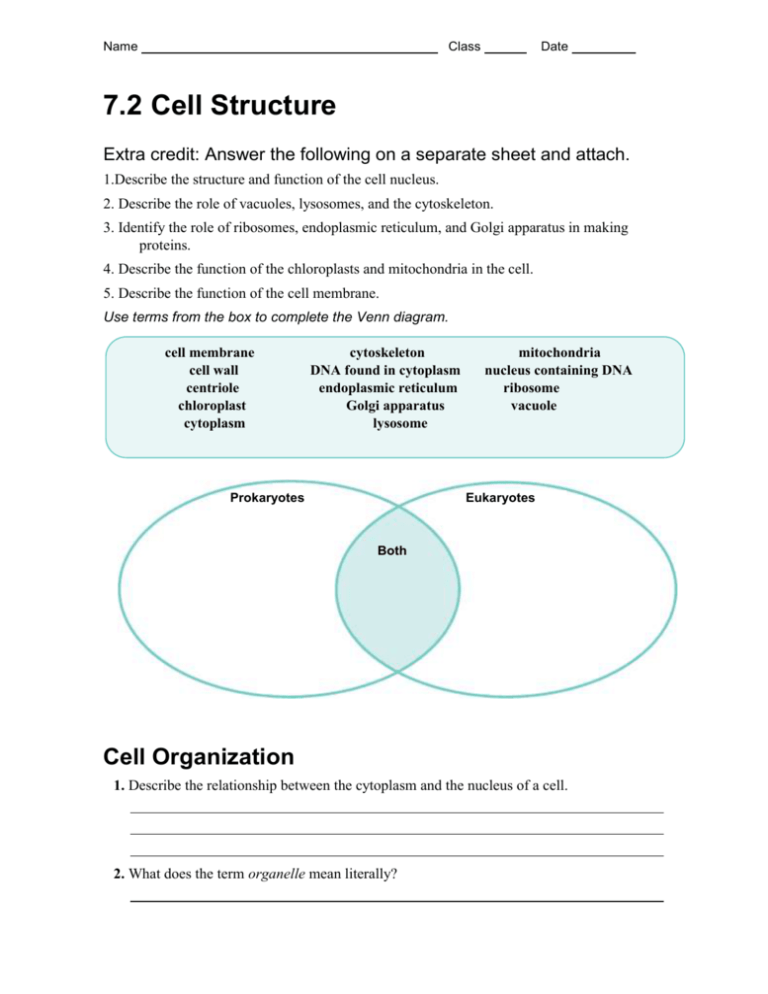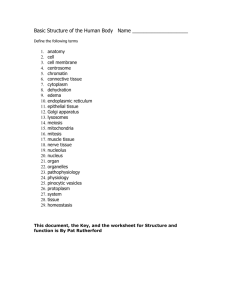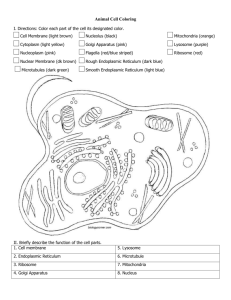013368718X_CH07_097-114.indd
advertisement

Name Class Date 7.2 Cell Structure Extra credit: Answer the following on a separate sheet and attach. 1.Describe the structure and function of the cell nucleus. 2. Describe the role of vacuoles, lysosomes, and the cytoskeleton. 3. Identify the role of ribosomes, endoplasmic reticulum, and Golgi apparatus in making proteins. 4. Describe the function of the chloroplasts and mitochondria in the cell. 5. Describe the function of the cell membrane. Use terms from the box to complete the Venn diagram. cell membrane cell wall centriole chloroplast cytoplasm cytoskeleton DNA found in cytoplasm endoplasmic reticulum Golgi apparatus lysosome Prokaryotes mitochondria nucleus containing DNA ribosome vacuole Eukaryotes Both Cell Organization 1. Describe the relationship between the cytoplasm and the nucleus of a cell. 2. What does the term organelle mean literally? An organelle is a specialized cell structure. Each organelle functions in a different way. All of the organelles help the cell carry out life processes. Use the terms in the box to write the name of the organelle underneath its picture. endoplasmic reticulum Golgi apparatus mitochondrion nucleus Function Organelle Controls most cell processes and stores genetic material Where lipid parts of the cell membrane and proteins for export are assembled and stored Modifies, sorts, and packages materials from the endoplasmic reticulum Converts the energy stored in food into a more usable form Organelles That Store, Clean Up, and Support 3. What are vacuoles? 4. What are the two roles of the central vacuole in plant cells? 5. How are contractile vacuoles different from other types of vacuoles? Cell Organization Follow the directions. 6. Use the words below to label the plant cell. Some structures have been labeled for you. cell wall chloroplast mitochondrion nucleus ribosome vacuole Plant Cell smooth endoplasmic reticulum Golgi apparatus rough endoplasmic reticulum cell membrane 7. Use the words below to label the animal cell. Some structures have been labeled for you. cell membrane Golgi apparatus mitochondrion nucleus rough endoplasmic reticulum ribosome Animal Cell smooth endoplasmic reticulum centrioles 8. Which structure is found in a plant cell but not in an animal cell? Circle the correct answer. chloroplast cell membrane ribosome 9. What is the main function of vacuoles? In the diagrams of the animal cell and the plant cell, label the structures indicated by the lines. 10. What is the role of lysosomes in the cell? Why is this a vital role? 11. Which structures of the cytoskeleton are found in animal cells but not in plant cells? 12. What other structures of the cytoskeleton would show the same pattern of microtubules as a flagellum? Organelles That Build Proteins 13. What are ribosomes? What do they do? 14. In which organelle are the lipid components of the cell membrane assembled? 15. What is the difference between rough ER and smooth ER? 16. Using the cell as a factory analogy, describe the role of the Golgi apparatus in cells. 17. Suppose a cell’s Golgi apparatus does not function properly. How might this problem affect other cells? Organelles That Capture and Release Energy 18. Complete the Venn diagram to compare and contrast chloroplasts and mitochondria. Chloroplasts Mitochondria True or false 19. Chloroplasts are never found in animal cells. 20. Unlike chloroplasts, mitochondria are surrounded by a double membrane. 21. Nearly all of the mitochondria in your cells were inherited from your mother. 22. Both chloroplasts and mitochondria lack genetic information in the form of DNA. Cellular Boundaries For Questions 23–25, complete each statement by writing the correct word or words. 23. Most cell support and protect cells. are porous to water and other materials but strong enough to 24. Nearly all of the plant tissue called is made up of cell walls. 25. Besides supporting and protecting a cell, the cell membrane and leaves the cell. what enters 26. Complete the diagram of a section of a cell membrane. Then, on the line below the diagram, write the name of the model that describes the cell membrane’s structure. 27. What is the function of vesicles in the synthesis of proteins and the release of those proteins outside the cell?







